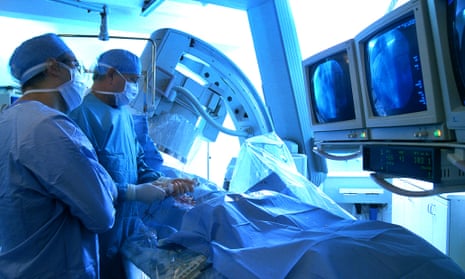A radical new treatment for heart disease could be developed after scientists found cells that can grow into fresh arteries and restore blood supply to the organ.
The work paves the way for natural bypass therapies that coax heart cells into forming new arteries capable of re-routing blood around diseased and blocked blood vessels.
Patients could have the treatment after a heart attack, or as a precaution if they are at risk, to give them extra arteries that would be ready to take over should their own become clogged.
“Whenever you have a blockage in a coronary artery, the blood supply is cut off, and you need a new supply,” said Kristy Red-Horse, who led the research with Katharina Volz at Stanford University in California. “We want to coax arteries to form and grow around the blocked area.”
In patients with coronary heart disease, the arteries that supply their hearts with oxygen-rich blood become narrowed by the build-up of fatty tissues. In some, this narrowing forces blood into a smaller network of neighbouring vessels that re-route blood around the diseased artery.
But these “collateral” blood vessels are not large enough to supply the heart with all the blood it needs. What Red-Horse hopes to do is grow fully fledged arteries that can take over when a heart attack strikes.
“What we really need to know is how to make these big arteries to allow a lot of new blood flow to come into the heart,” she said.
Until now, one of the main obstacles to such a therapy has been scientists’ lack of understanding of how coronary arteries form. In particular, it was unclear which heart cells formed smooth muscle sheaths needed to form new arteries, and whether they existed in adults.
Writing in the journal eLife, the Stanford team describe how they tracked down the cells that forms arterial muscle in adult mice. They began by adding a fluorescent tag to a single cell in the epicardium, the tissue layer that covers the heart.
The tag allowed the scientists to trace the epicardial cell and all the generations of cells it gave rise to as it divided. The researchers noticed that some of the cells went on to become arterial muscle cells. Working backwards from these, they identified the originating cells for arterial muscle, called pericytes.
In further tests, the team worked out the molecular signals that tell pericytes to grow into arterial muscle cells. If the signals can be mimicked by a drug, then heart cells could potentially be persuaded to form fresh arteries on the heart’s surface, through which blood can flow.
The team has not done studies on the human heart yet, but the shared physiology with the mouse heart makes them confident that the findings could help people. Red-Horse hopes to be growing new arteries in mice in the the next five years.
There is a severe need for new treatments for heart disease and heart attacks. About 124,000 people in the UK suffer heart attacks each year, and one in three die before they reach hospital.
The existing treatment for patients with obstructed arteries is angioplasty to remove the material causing the blockage, but often the blockage returns.
Bypass surgery, in which blood vessels are used to bridge the blocked region, is often successful, but scientists such as Red-Horse believe regenerating arteries may work better.
“It remains to be seen how quickly we can grow them, and would that be quickly enough,” she said.
Jeremy Pearson, associate medical director at the British Heart Foundation, said: “By proving that pericytes are triggered to differentiate into smooth muscle cells in the developing heart, the Stanford group has reinforced the possibility that the same process can be replicated in the adult heart.
“Pericytes could then be used to grow the new blood vessels needed to successfully repair damage after a heart attack.”
The BHF is funding research in pigs to learn whether pericytes gathered from other blood vessels and delivered to the heart can improve tissue repair. If the experiments are successful, they will pave the way for clinical trials in people.
“Regenerative medicine research of this kind is likely to drive major advances in treating both heart disease and heart attacks,” said Pearson.
